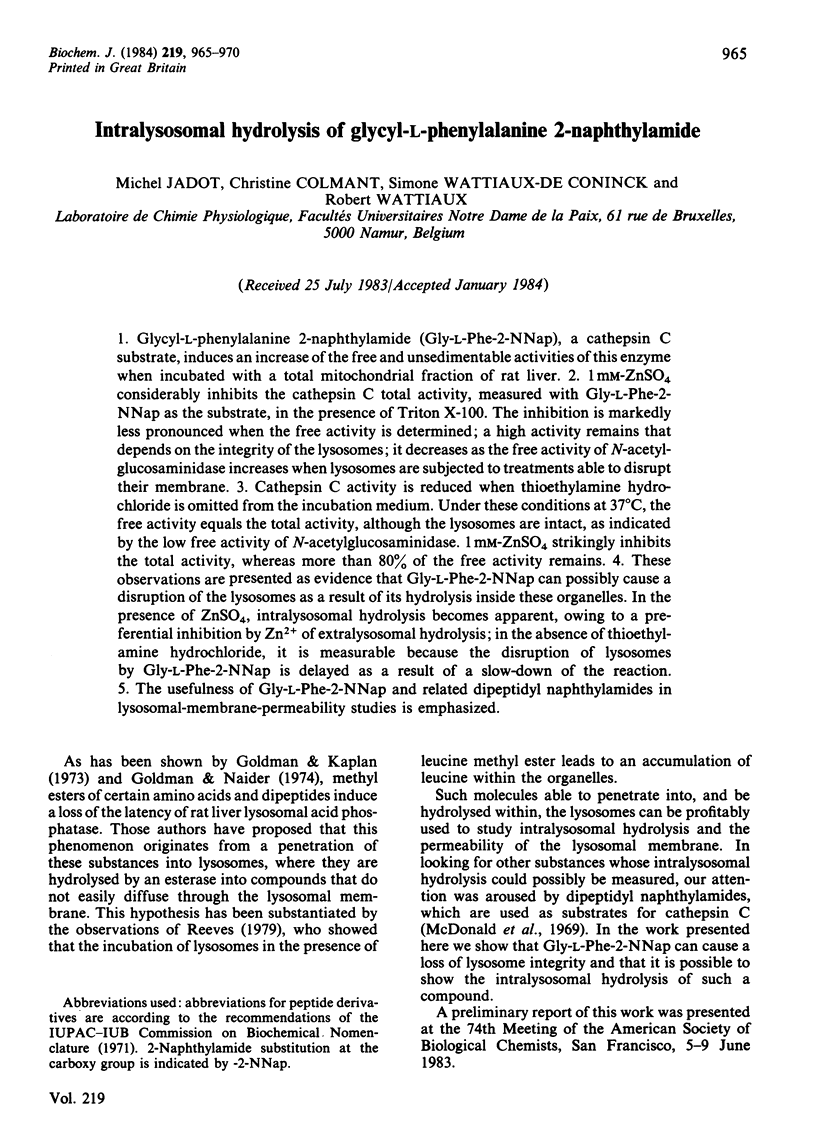Abstract
Glycyl-L-phenylalanine 2-naphthylamide (Gly-L-Phe-2-NNap), a cathepsin C substrate, induces an increase of the free and unsedimentable activities of this enzyme when incubated with a total mitochondrial fraction of rat liver. 1 mM-ZnSO4 considerably inhibits the cathepsin C total activity, measured with Gly-L-Phe-2-NNap as the substrate, in the presence of Triton X-100. The inhibition is markedly less pronounced when the free activity is determined; a high activity remains that depends on the integrity of the lysosomes; it decreases as the free activity of N-acetylglucosaminidase increases when lysosomes are subjected to treatments able to disrupt their membrane. Cathepsin C activity is reduced when thioethylamine hydrochloride is omitted from the incubation medium. Under these conditions at 37 degrees C, the free activity equals the total activity, although the lysosomes are intact, as indicated by the low free activity of N-acetylglucosaminidase. 1 mM-ZnSO4 strikingly inhibits the total activity, whereas more than 80% of the free activity remains. These observations are presented as evidence that Gly-L-Phe-2-NNap can possibly cause a disruption of the lysosomes as a result of its hydrolysis inside these organelles. In the presence of ZnSO4, intralysosomal hydrolysis becomes apparent, owing to a preferential inhibition by Zn2+ of extralysosomal hydrolysis; in the absence of thioethylamine hydrochloride, it is measurable because the disruption of lysosomes by Gly-L-Phe-2-NNap is delayed as a result of a slow-down of the reaction. The usefulness of Gly-L-Phe-2-NNap and related dipeptidyl naphthylamides in lysosomal-membrane-permeability studies is emphasized.
Full text
PDF





Selected References
These references are in PubMed. This may not be the complete list of references from this article.
- Amar-Costesec A., Beaufay H., Wibo M., Thinès-Sempoux D., Feytmans E., Robbi M., Berthet J. Analytical study of microsomes and isolated subcellular membranes from rat liver. II. Preparation and composition of the microsomal fraction. J Cell Biol. 1974 Apr;61(1):201–212. doi: 10.1083/jcb.61.1.201. [DOI] [PMC free article] [PubMed] [Google Scholar]
- DE DUVE C., PRESSMAN B. C., GIANETTO R., WATTIAUX R., APPELMANS F. Tissue fractionation studies. 6. Intracellular distribution patterns of enzymes in rat-liver tissue. Biochem J. 1955 Aug;60(4):604–617. doi: 10.1042/bj0600604. [DOI] [PMC free article] [PubMed] [Google Scholar]
- Goldman R., Kaplan A. Rupture of rat liver lysosomes mediated by L-amino acid esters. Biochim Biophys Acta. 1973 Aug 22;318(2):205–216. doi: 10.1016/0005-2736(73)90114-4. [DOI] [PubMed] [Google Scholar]
- Ludwig J. C., Chvapil M. Reversible stabilization of liver lysosomes by zinc ions. J Nutr. 1980 May;110(5):945–953. doi: 10.1093/jn/110.5.945. [DOI] [PubMed] [Google Scholar]
- McDonald J. K., Zeitman B. B., Reilly T. J., Ellis S. New observations on the substrate specificity of cathepsin C (dipeptidyl aminopeptidase I). Including the degradation of beta-corticotropin and other peptide hormones. J Biol Chem. 1969 May 25;244(10):2693–2709. [PubMed] [Google Scholar]
- Mcelhaney R. N., de Gier J., van der Neut-Kok E. C. The effect of alterations in fatty acid composition and cholesterol content on the nonelectrolyte permeability of Acholeplasma laidlawii B cells and derived liposomes. Biochim Biophys Acta. 1973 Mar 16;298(2):500–512. doi: 10.1016/0005-2736(73)90376-3. [DOI] [PubMed] [Google Scholar]
- Misaka E., Tappel A. L. Inhibition studies of cathepsins A, B, C and D from rat liver lysosomes. Comp Biochem Physiol B. 1971 Apr 15;38(4):651–662. doi: 10.1016/0305-0491(71)90268-9. [DOI] [PubMed] [Google Scholar]
- Pfeiffer C. J., Cho C. H. Modulating effect by zinc on hepatic lysosomal fragility induced by surface-active agents. Res Commun Chem Pathol Pharmacol. 1980 Mar;27(3):587–598. [PubMed] [Google Scholar]
- Reeves J. P. Accumulation of amino acids by lysosomes incubated with amino acid methyl esters. J Biol Chem. 1979 Sep 25;254(18):8914–8921. [PubMed] [Google Scholar]
- Reeves J. P., Reames T. ATP stimulates amino acid accumulation by lysosomes incubated with amino acid methyl esters. Evidence for a lysosomal proton pump. J Biol Chem. 1981 Jun 25;256(12):6047–6053. [PubMed] [Google Scholar]
- Reijngoud D. J., Tager J. M. The permeability properties of the lysosomal membrane. Biochim Biophys Acta. 1977 Nov 14;472(3-4):419–449. doi: 10.1016/0304-4157(77)90005-3. [DOI] [PubMed] [Google Scholar]
- Steinman R. M., Mellman I. S., Muller W. A., Cohn Z. A. Endocytosis and the recycling of plasma membrane. J Cell Biol. 1983 Jan;96(1):1–27. doi: 10.1083/jcb.96.1.1. [DOI] [PMC free article] [PubMed] [Google Scholar]
- Wattiaux R., Wattiaux-De Coninck S., Ronveaux-dupal M. F., Dubois F. Isolation of rat liver lysosomes by isopycnic centrifugation in a metrizamide gradient. J Cell Biol. 1978 Aug;78(2):349–368. doi: 10.1083/jcb.78.2.349. [DOI] [PMC free article] [PubMed] [Google Scholar]
- de Duve C., de Barsy T., Poole B., Trouet A., Tulkens P., Van Hoof F. Commentary. Lysosomotropic agents. Biochem Pharmacol. 1974 Sep 15;23(18):2495–2531. doi: 10.1016/0006-2952(74)90174-9. [DOI] [PubMed] [Google Scholar]


